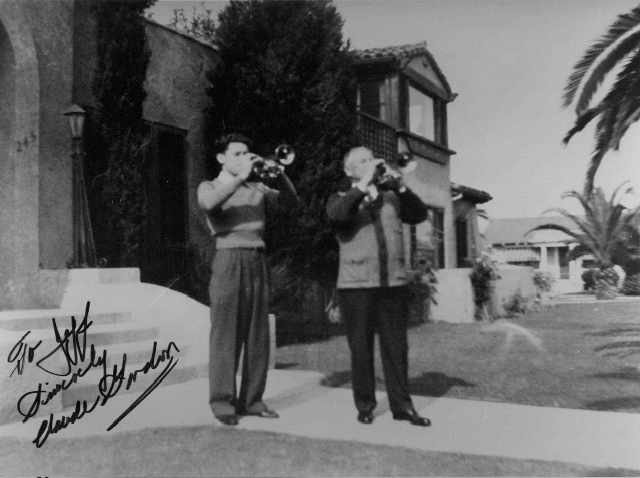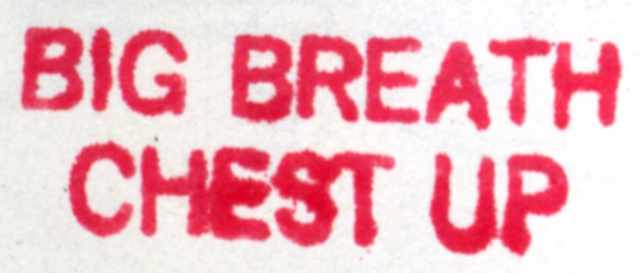Claude Gordon and Herbert L. Clarke (The Brass Herald)
Claude Gordon and Herbert L. Clarke are two of the most significant names in brass playing history. They both enjoyed exceptional playing careers, authored books, designed instruments and had an enormous impact on professional brass players in their private teaching and through their books. Claude studied with Clarke ten years after moving the Los Angeles from Montana in the middle of the 1930s Great Depression. The content of their teaching was identical.
Claude Gordon and Herbert L. Clarke

The identical content is clearly seen when looking at the seven basic items as listed by Herbert L. Clarke in Setting Up Drills and the same items listed in Claude Gordon’s Systematic Approach. These items focus on the mechanics of playing a brass instrument and not a style of music. In my ten years as a student with Claude I never heard him say he would make a student into a particular kind of musician, just simply that he would show them how to play correctly.
As stated in the previous article, Claude reasoned that because the laws of nature don’t change we can understand and eliminate worry from our playing. Claude also believed that every student was capable of becoming a great player if they practice correctly and persevere. These fundamentals, as simple as they are, can be the source of eliminating worry while developing greater skill.
Each of the seven items interact with each other. These are the primary things that make brass playing work. Some err in making secondary items into primary items. Others misunderstand one or more of these items. If they all function correctly the player will be able to obtain the maximum skill.
1. Wind Power
Wind power refers to the strength behind the blowing. Strength must be developed before control. Therefore, at first you must not play too soft. Extremely soft playing takes just as much power, but more control. This comes later. If not, you will have neither power nor control. Compare a train to a car traveling at the same slow speed. The train has much more power behind it despite the slow speed. Wind power is like that.
Correct breathing involves correct posture and taking a full breath every time you begin. Claude said, “Big Breath, Chest Up.” If your chest drops you lose power. It is now known that diaphragmatic breathing is a misnomer and the cause of much confusion in brass playing (See Brass Playing Is No Harder Than Deep Breathing by Claude Gordon, p. 16-17).

2. The Tongue
The tongue does much more than just articulation. It must first be understood that the tongue controls the velocity of the air coming out of the mouth. When going higher the tongue rises and moves forward into an arched position, as in pronouncing an “Eee” vowel sound. When descending, the tongue flattens into an “Aww” vowel. Claude’s term “Tongue Level” means that for every single pitch the tongue has a specific level or shape in the mouth. High velocity air causes the lips to vibrate faster and produce high notes.


Correct single tonguing makes sense in light of “Tongue Level.” Clarke said, “My tongue is never rigid when playing, and rests at the bottom of my mouth, the end pressed slightly against the lower teeth. I then produce the staccato, by the centre of the tongue striking against the roof of the mouth.” - Characteristic Studies, p. 5. Claude referred to this as “K Tongue Modified” or “KTM” because it is similar to K tonguing, but more forward on the tongue. Tonguing any other way (i.e. tip going up to top teeth) will result in a disruption of the arch of the tongue in the front of the mouth and more movement of the tongue. Understanding this will help to answer how you can play perfectly accurate in the extreme high register, without cracked notes, and how to single tongue faster. Everyone uses “Tongue Level” in their playing, even if they don’t know it. But, KTM is not taught or understood by many people.

Claude’s point was to learn by observing the tongue movement saying, “The tongue will teach you more than I can explain.”
3. Wind Control
Wind Control is controlling the strength of the wind power. The player must first learn to play stronger when ascending and lighter when descending because the resistance increases as the tongue arches. If the player plays too soft the notes won’t respond. “Never play softer than you can get a sure sound” was a mantra of Claude Gordon. Wind power and tongue level must work in a coordinated manner. “The air does the work, the tongue channels the pitch” said Claude. As the player develops, other aspects of control can be focused on. Playing many times in one breath, playing in a whisper and playing softer when ascending are some of the skills that require more development and come after strength is built. Clarke said, “Perhaps now you will realize that much more benefit is derived from playing these exercises in one breath than by holding long tones.” - Technical Studies, 6th Study, p. 29.
4. The Fingers Of The Right Hand
The valves must be struck on the ball of the fingers, and not pressed on the tip. The fingers must lift high off the valves in order to train a definite quick response. This is not slower as some think, but actually develops greater speed. The right thumb should be straight and slightly on the side of the first valve casing closest to the mouthpiece. This places the fingers into a relaxed yet strong position to work the valves. The little finger should be out of the hook for easier mobility of the third finger. The fingers of the right hand are frequently worked-on in conjunction with wind control, in being able to play clean enough and fast enough to do exercises many times in one breath.

5. The Left Hand
The left hand must carry the weight of the instrument to allow the fingers of the right hand to function properly. The grip should be firm, yet the wrist should be flexible to move with the face and jaw. The valve casing should rest in the palm of the hand. An attitude of taking total control of the instrument is also reinforced by a solid grip. “You are the boss!” said Claude. The valve casing should not be tilted to one side or another because it will interfere with the curve of the fingers of the right hand.
6. The Muscles Of The Face
The muscles of the face adjust to keep the lips vibrating. They contract slightly when ascending and relax when descending. This should not be dwelt on too much. Claude said, “Forget about your lip!” The contracting motion is significant to not fall prey to bad habits such as smiling, pinching, puckering and other unnatural responses. Practice of tongue level exercises along with accenting higher notes ties everything together and makes the muscles of the face work properly.
7. The Lips
The lips’ only function is to vibrate. The lips are a vibrating medium similar to the cone in a loudspeaker or a double reed on an oboe. Something else must act to make the lips vibrate and produce any given pitch. Wind power and tongue level are the primary cause, and the vibration of the lips is the secondary effect. There is, however, an ideal place to position the mouthpiece with 2/3 on the top lip in order to achieve a freer vibration. The ability to play high notes has nothing to do with the strength of the lips. The lips must be flexible and able to respond easily. Care must be taken to not abuse the lips, or do things that hinder their free vibration. Arban said, “Under no circumstances should...the lips make noise in the mouthpiece even though many performers appear to think otherwise. The sound forms itself...”-p. 10. Claude also said to not buzz. Rest with the mouthpiece off the lips to avoid fatigue, tightness and developing bad habits. Practice pedal tones and tongue level exercises to develop a free vibration, moving away from being lip conscious.
Stop thinking that what is required is talent or luck. There is no such thing as luck! Avoid gimmicks. Clarke said, “Try to derive a common sense idea of everything and use your brains in thinking over all suggestions. Try to get away from tradition and superstition, which has ruined so many players.” (Setting Up Drills, p.4)
The next article will deal with how to apply these principles to a structured practice routine involving various books.
Jeff Purtle studied ten years with Claude Gordon, taught at the CG Brass Camps, and was certified directly by Dr. Gordon to teach according to his principles. Jeff has taught since 1984 and in 2004 added live video chat students to his Greenville, South Carolina studio.
Published by The Brass Herald - December 2008


